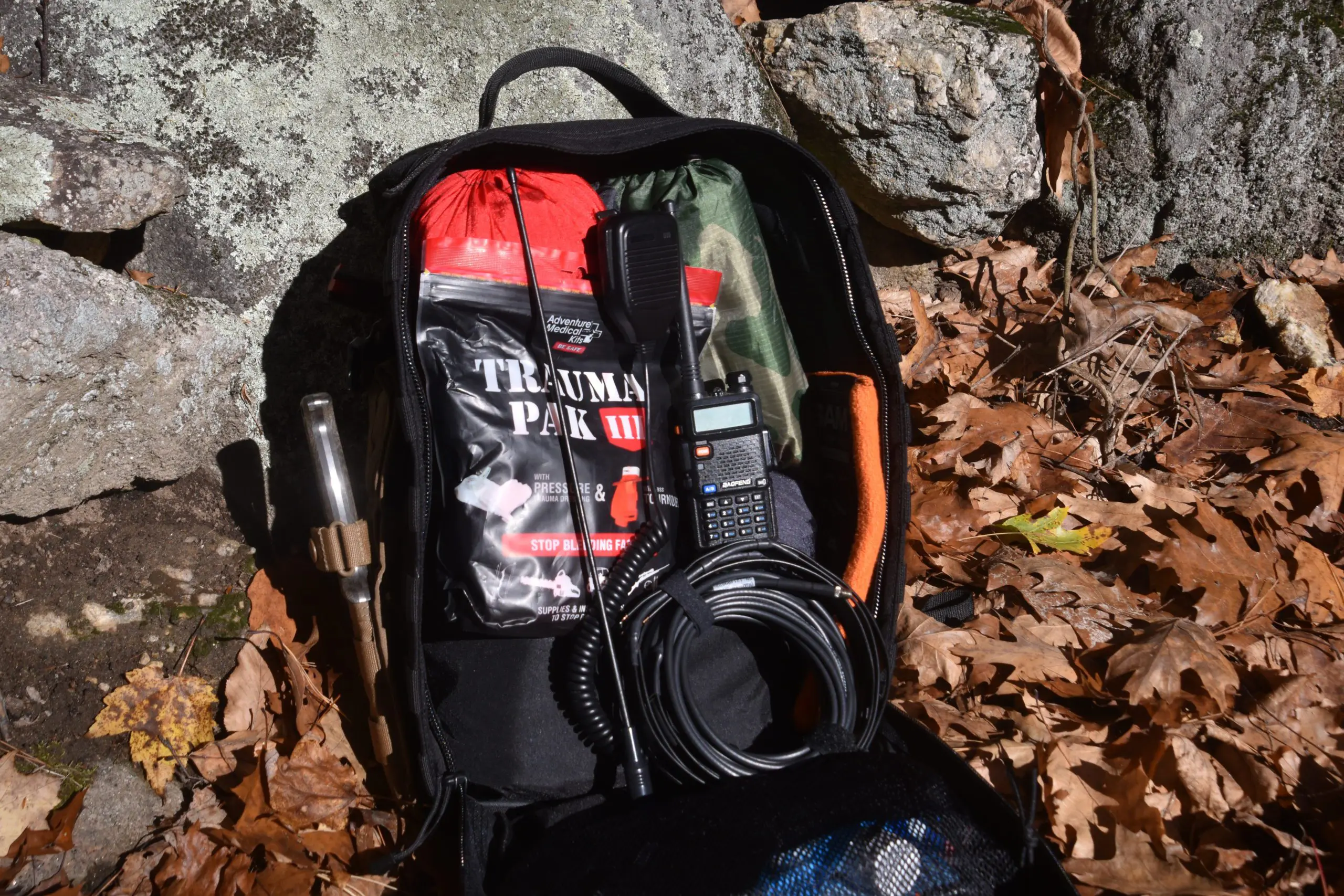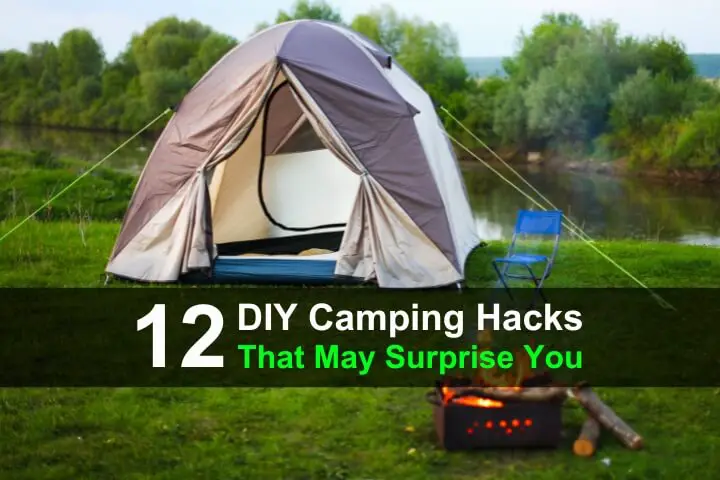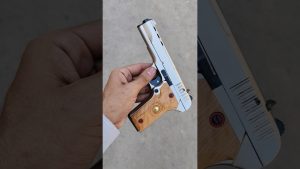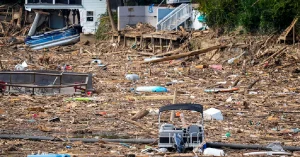SHTFPreparedness may collect a share of sales or other compensation from the links on this page.
If the grid fails, it will take away our ability to communicate with it. Everyone outside walking distance will fade to memories if we can no longer reach out.
The convenience of simply picking up a phone to communicate will suddenly vanish. This ham radio guide for preppers will re-open communication channels around the block and around the world.
Ham radio is one of the few forms of emergency communication for information exchange across vast distances. From simple verbal communication to the exchange of text to the sharing of images, ham radio can do it all.
You just need to know the best type of radio to use, especially when the cell phones are turned off and the televisions are silent.
Overall, the ability to share information and intelligence could mean the difference between comfort and concern when you are no longer in touch with the rest of the world.
How to Use Ham Radios When SHTF?

Information exchange is vital to our success during SHTF. Whether it’s knowing what’s happening over the next hill or across the country, information provides a complete picture of the world.
Undeniably, CB radios and walkie-talkies are okay for talking across your property or your town, but that’s the extent of their capabilities.
In most cases, especially for “blister-pack” walkie-talkies, their range is severely overstated. In contrast, ham radios, with their increased wattage, improved antennas, and additional frequencies, can reach the edge of the horizon and beyond.
Ham radio allows you to communicate over various distances.
- Line of sight distances: approximately 0–60 miles, depending on many factors
- UHF/VHF, also called 2-meter/75-centimeter, also called 144 MHz/440 MHz
- These frequencies often use repeaters to extend their range by receiving a signal and then repeating the signal at separate frequency
- NVIS: approximately 500 miles using specialized antennas
- HF 6- to 160-meters some bands are better suited for NVIS than others
- Around the country and the world
- HF bands 6- to 160-meters
Ham Radio Modes
First, when thinking about ham radio, we often associate it with only talking into a microphone. There is value in verbal communication.
From warning signals at checkpoints to welfare checks with neighbors, during the SHTF, there will be times when sending a runner is too slow or impossible. Without a doubt, ham radio wins every time.
Additionally, ham radios, with the proper equipment, can also trade text messages during SHTF. The advantage of these protocols is that they employ error correction.
This increases the probability that your message gets through accurately. Unlike voice, which can be subject to interpretation, text messages are much easier to understand.
Finally, there are more fringe aspects of ham radio related to intelligence gathering. Again, with the right equipment, you can not only trade text but also images. You can also download NOAA weather maps and satellite imagery.
During a grid-down event, what would you give to see tomorrow’s weather? How about tracking down the source of a local broadcast? These are all part of ham radio.
Ham Radio Licensing Requirements
Unlike FRS or MURS, ham radio requires a license. Technically, GMRS requires a license, but it’s an easy pay-to-play license.
You must have a ham radio license to broadcast. If you want to talk, you need to be licensed. You can have all the equipment in the world to listen.
But to key up, you need your ticket. One caveat to the licenses. During an emergency, you don’t need one. However, ham radios have a learning curve, so it’s best to get licensed and practice now before you need these skills.
If you can read and memorize a few basic concepts, then the only thing between you and a ham license is a few hours of studying. One other note: the requirement to know Morse code was removed many years ago.
Technician License
The entry-level ham ticket is a technician license. At this level, operators may use most “line of sight” frequencies. This includes the 2-meter and 75-centimeter bands.
The one high-frequency band where access is granted is the 6-meter band. While this band isn’t too popular, it will grant you long-distance communications.
2 m and 75 cm are used for short distances. Often, you will find dual-band radios that cover both frequencies. We will get into this in a bit.
General License
The general ham license is the sweet spot for preppers. With a general license, you get access to most of the amateur-allowed HF spectrum. These frequencies include 10m up to 160m (and a few others).
These frequencies give you the ability to work long distances and around the world. With the right equipment (radio, antenna, etc.), the communication world is your oyster. Heat up the clouds and prepare to share information!
Extra License
The extra license opens up a few additional radio frequencies for the amateur operator. Once you get into ham radio, you will need to decide if the additional studying is worth it.
radio frequencies
Ham Radio Testing and Resources
The great thing about studying for your ham radio license is that it’s pretty easy. Each test (technician, general, and extra) comprises a round of multiple-choice questions. Even better, they give you the entire question pool to study!
For the technician and general tests, there are 35 questions, and you need to get 26 or more correct to pass. The test pools for each are 423 and 454 questions, respectively. If you have the mind to, you can memorize them.
If memorization isn’t your thing, there are several guides, websites, and applications that can help you study.
First, you can download them directly from the source. The American Radio Relay League (ARRL) hosts the test for the Federal Communications Commission (FCC). They have links to download the question pools directly.
If you prefer to read your study materials or listen to audiobooks, there are too many books to count.
As you would expect, there are also study apps for your phone. Just hit the Apple or Google stores for the one that fits your style of learning.
Finally, local ham radio clubs often offer “TechnicianGeneral in a Weekend,” where you dedicate a few days to learning and you test at the end of the event.
I’ve always heard great things about these classes and know several people who have passed with flying colors after only these few days of prep.
Types of Ham Radios
We differentiate radio systems by the frequencies they cover, their form factor (size), and the additional features they have.
Here are some of the most common types of ham radio systems:
Handi-Talkies
Handi-talkies can also be called walkie-talkies by non-ham’s. A handi-talkie is best classified as one of the smallest emergency radios you can purchase.
As their name suggests, these radios are sized to be portable and fit nicely in your hand. Most are low-powered (2–10 watts) and support the UHF and VHF bands.
This means that you are limited in your line of sight. In reality, these reach out to a maximum of 30 miles if the conditions are perfect.
One advantage of handi-talkies over blister-pack walkie-talkies is that the antennas are interchangeable. Simply put, the bigger the antenna, the better your ability to transmit and receive.
Most short antennas will get you out a few miles. Replace this with a ¼ wave or ½ wave antenna, and you will achieve the maximum your radio offers.
Most handi-talkies are fairly limited in their functionality. As the price goes up, you can get features such as digital modes.
Mobile
Mobile radios are the next step up in size and functionality. Most mobile radios are well suited to fit in a vehicle or as a mini base station.
The additional size allows the radios to push a little more power. Many mobiles can push 50 or more watts.
As they are designed to fit into a vehicle, they don’t come with a power supply and rarely come with an antenna. You will need to provide a 12-volt source. This can be a battery or a dedicated power supply (if you are using it as a base station).
There are a myriad of antennas. You simply need to mate up the connector the radio requires with your antenna.
Mobile radios usually cover at least 2 meters or 75 centimeters, often both. There are several on the market that provide HF frequencies as well.
Be prepared to pay for these radios, though. Finally, there are several that you can configure as repeaters.
Base Stations
Base stations are where you gain the ability to reach out and touch someone.
Larger size, more power, and better electronics provide functionality that you can’t achieve in smaller radios. Many output 100 watts and cover many of the high-frequency bands. But that’s just the beginning.
With the additional size, base stations can dedicate space to advanced displays and digital signal processors. The processors filter out transmission noise and bring out even the faintest of signals.
A base station can be a hefty investment. But it doesn’t stop there. When you buy the transceiver, you are only getting the radio.
You will also need to purchase a power supply, an antenna, an antenna tuner, and speakers. And you may wish to upgrade the microphone by adding an amplifier. Don’t forget the computer so you can take advantage of all the cool digital modes!
Where to Buy a Ham Radio
If you are a beginner operator, I highly recommend only purchasing new radios or used ones from an experienced and trusted source.
Basically, radios are too expensive to risk getting one that requires repairs or has a spotty history.
Luckily, there are several brick-and-mortar as well as online shops that carry a wide variety of new radios.
Home Radio Outlet (HRO)
Ham Radio Outlet is one of the largest ham-specific online retailers with a physical presence. Indeed, with stores from the west coast to the east coast, there is bound to be one in your area. If not, check out their online store.
Amazon
The ubiquitous Amazon.com has a wide variety of major brands, from ICOM to Yeasu, to AnyTone. In fact, when the Baofeng craze hit the prepper community, you could buy them at Amazon for a price affordable to any prepper.
Ham Radio Flea Markets
Next, I’d be remiss if I didn’t mention ham flea markets. On one hand, these events are a wonder to behold. On the other hand, they are paralyzing to the novice due to their enormity.
I’ve never seen so many radios, accessories, and components in one place. Most of the gear is used. It is best to go with an expert who can help you assess anything you want to purchase.
Ham Clubs and Silent Keys
Finally, there are local clubs. Throughout my life, I’ve been the beneficiary of others’ generosity. I’ve also tried to share and give in return.
Not only are ham clubs some of the best places to learn, but everyone seems to have a spare accessory or two. Sometimes you can get the best value if club members know you are just starting out and looking to invest or upgrade.
When a ham operator passes away, club members refer to them as a silent key. When an operator passes, their family can be eager to sell or pass along their gear to another enthusiast.
Recommended Prepper Ham Radios
Let’s look at some of the most popular ham radios for preppers.
Baofeng UV Series
I firmly believe that the inexpensive Baofeng radios started the recent prepper communication drive. While they aren’t the most rugged radios or the easiest to program, they are inexpensive.
Comparatively, you can buy 3 or 4, plus accessories, for the cost of one of the other radios on this list. For that price, they are disposable. They also have a huge following, which means there are lots of resources to learn from.
The Baofeng BF-F8HP is the third generation of this dual-band (2-meter and 75-centimeter) UV-5R.
When you purchase one, get a programming cable and a larger antenna.
The programming cable lets you quickly program this otherwise unwieldy radio.
An improved antenna will get everything possible out of this radio, including increased reception and transmission range.
If you want some extra reach in a small package, invest in a dual-band J-pole roll-up antenna.
Other Handi-Talkies
Upgrading from the Baofeng, there are several radios from Yeasu, ICom, and Kenwood. A great option is the Yeasu FT-65. This handi-talkie is also dual-band and 5 watts. It is more rugged, with an IP54 rating.
The ICom IC-T70A has a similar set of features to the Yeasu, including dual-band, 5 watts, and the ability to store over 300 frequencies.
Mobile Radios
Moving up to mobile radios, you get more bang for the buck. The AnyTone AT-778UV is a dual-band transceiver. It can push 25 watts in a compact package.
For a compact and rugged single-band (144 MHz) radio, I recommend the Yeasu FT-2980R single-band transceiver. This radio has the ability to push 80 watts at its maximum settings.
For the complete mobile solution, there is the Yeasu FT-891. This mobile package covers 6-meters to 160-meters and can transmit with 100 watts of power.
In contrast to the other radios here, the FT-891 has a detachable head (screen) that lets you mount the radio where it is convenient and the head where it is visible.
While it may be true that this radio has the price tag of some base stations, it also has these capabilities in a much more portable package.
Beginner Base Station
Base stations represent a major investment in your ham radio hobby. With that in mind, I’ll recommend a simple base station that is fully functional but not overkill.
The ICom IC-718 is an all-band radio that covers 10-meters to 160-meters. Comparatively, it doesn’t have the digital signal processing features (e.g., noise reduction) or digital modes of more full-featured radios.
It also does not have digital modes like its big brothers. Where it lacks in features, it gains in simplicity.
In comparison to the experts, as a beginner ham, you will benefit from the ease of use of the IC-718. Instead, as you journey farther down the path, you will learn more and benefit from the advanced features of other radios.
Learn the basics now and invest in advanced tools later.
Ham Radio Training Opportunities
Ham radio skills are perishable. Specifically, if you don’t use them, you’ll lose them. In this case, you need training.
The good news is that ham radio is a popular hobby, and there are several organizations dedicated to keeping skills sharp.
The Amateur Radio Emergency Service (ARES) and the Radio Amateur Civil Emergency Service (RACES) are both civilian organizations dedicated to the use of ham radios during emergencies.
Both groups practice regularly and hold local and national events dedicated to both basic and advanced skills, such as passing simple messages and coordinating complex networks for data exchange.
The prepper community has its very own radio organization for communications. Specifically, I’m talking about the American Redoubt Radio Operators Network (AmRRON).
AmRRON is a collection of prepper radio operators. AmRRON has formalized radio communication through frequencies, time windows, and digital modes.
Chiefly, they host formal networks where operators practice exchanging situation reports in both spoken and digital forms. For the past several years, they have hosted T-Rex, an annual exercise based on potential nation-wide grid-down events.
Each T-Rex event selects a potential disaster and presents a week’s worth of build-up with mock-news reports sent via the internet and radio.
Next, as the event builds, it kicks off for real with the announcement that the grid has failed, and they instruct you to power down your house and, in a similar fashion, power up your communication gear.
Finally, over the weekend, the networks operated according to AmRRON’s operating instructions. I’ve never seen a more professionally run exercise. Even if you don’t take part fully, you can gain a lot by just following along.
Saying 73 to Ham Radio for Preppers
Communication is something that we take for granted. We use cell phones. Radios are always on in the background. The television is always on. The internet is a constant and consistent form of connection between us.
But what if the lights go out, the internet goes down, and all radio services stop? How will you communicate?
Ham radios for preppers are one of the best methods for exchanging information when all the familiar methods have gone. It takes tools.
It takes knowledge. Most importantly, it takes proficiency. Undeniably, there is no better time than now to start on your path to communicating with ease.

















